Why do we Prune Fruit Trees?
The reasons we often choose to prune fruit trees are:
- To keep the trees smaller to enable netting
- To keep the trees smaller to pick the fruit
- Because we think they need pruning to improve yield fruit (they don’t!)
- Because we are told that we need to prune fruit trees by others in the industry
- To maintain a shape or aesthetic that pleases us
- To thin out dead wood
- To improve airflow (to prevent fungal disease such as curly leaf)
- To strengthen the tree

Most of these issues can be solved through using dwarfing rootstocks. By using dwarf rootstocks you remove the need to prune fruit trees. Reducing fruit tree pruning, should lead to healthier trees with longer life spans.
Got a big fruit tree that you want to make small? Head straight here to find out more.
'Less is More' when Pruning
If left to themselves, most fruit trees will grow for hundreds if not thousands of productive years. They don’t need pruning to produce fruit and they will survive quite happily without human intervention.
The problem with pruning a tree is that it involves damaging some of the tree’s resilience. The bark on the outside of the tree exists to protect the cambium layer and the dead heartwood of the tree. Once fungi find their way in through the bark of the tree, they can set to work slowly breaking down and consuming the heartwood. Eventually these fungi will find their way into the trunk of the tree and slowly destroy it.

By pruning the tree, you are allowing fungi (and other diseases) to invade the otherwise defenceless part of the tree. This reduces the lifespan of the tree from hundreds or thousands of years to decades (or less).
The larger the cuts you make on your tree (e.g. larger limbs) the faster the fungi can invade and colonise the tree and often the faster its decline will be.
The more susceptible trees such as Apricots and Cherries will decline faster through pruning than say a plum, but they all will decline eventually.
Using dwarfing rootstocks reduces the need for pruning and therefore the risk of introducing disease.
Disease Prevention in Fruit Trees
There are many viral, fungal and bacterial diseases that can infect fruit trees. Some can have a detrimental impact on your fruit trees and cause them to die. One of the easiest ways to transfer these diseases between trees is through poor pruning hygiene, or pruning at the wrong time of the year.
Utilising good pruning practices, will help to ensure that your trees stay strong and healthy for longer. This includes avoiding cross contamination between trees. Try to get into the habit of sterilising your tools between trees (and especially between gardens). Prune your trees at the right time of the year. Keep them as stress free as possible through appropriate watering and fertilizing. Planting your trees in the right spot in the first place can also help with this!
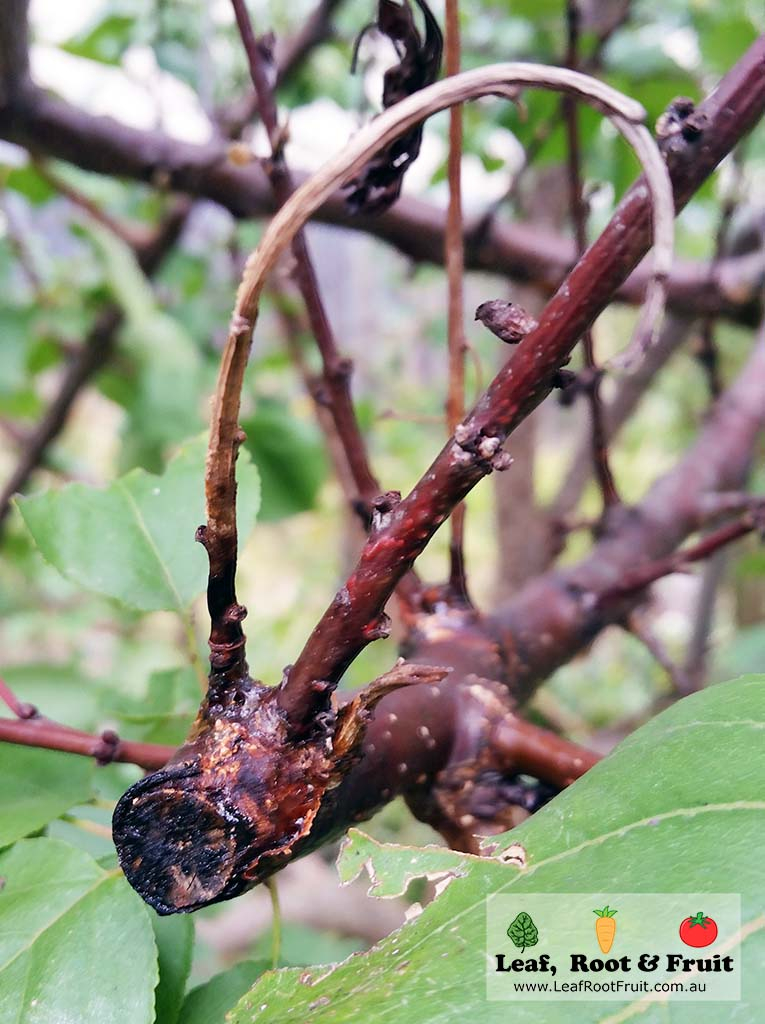
Timing of pruning to avoid disease
The timing of your fruit tree pruning is vital to prevent introduction of disease. This is especially the case for cherries and apricots.
Fruit trees are best pruned when they are actively growing. This enables them to heal wounds faster. Avoid pruning susceptible trees (e.g. Apricot or cherry) on cold or humid days, and never when there is a strong chance of rain.
All deciduous trees go through an annual cycle. They break dormancy in spring, when the sap flows from the trunk and branches, out to the growing tips and puts on new growth. The tree continues to grow through summer until autumn. During autumn the sap flow reverses and is drawn back into the tree.
If you prune a tree in autumn, the reversed sap flow will draw any pathogens introduced at the cut, down into the trunk. It will help diseases spread. Never prune fruit trees during this time. If the leaves have started to change colour, then it is best not to prune susceptible trees. More resilient trees such as plums, apples and pears are less of an issue to prune in autumn, although it’s best to wait until winter.
From a prevention of disease perspective, the best time to prune an apricot or cherry is when it is actively growing in spring or summer. I would avoid pruning Apricots and Cherries in autumn or winter.
Sterilisation of Tools
Sterilisation of tools is incredibly important in preventing the introduction of disease. A mixture of 70% Methylated spirits and 30% water is a great sterilisation agent. Others advocate for using bleach based solutions.
Get into the habit of sterilising all your tools between trees, especially if you are using the tools in other gardens. If you have infected trees in your garden, always prune these last and consider sterilising tools in between infected and non-infected areas.
Sealing of Wounds
Historically the garden industry has advocated sealing major tree wounds with tar or other sealants. This practice has now widely ceased, allowing wounds access to good airflow and to heal themselves. Using a sealant potentially seals the pathogens into the tree and can exacerbate any problems.
Fruit Tree Pruning Tools and Equipment
A good set of fruit tree pruning tools should last you a lifetime. Get the best quality equipment your gardening budget can afford. I have spent a small fortune on pruning equipment over the years. The cheap tools sourced from your local hardware store lasts about 4 weeks in my business, before it breaks. I get several years out of the more expensive equipment. The more expensive equipment has much stronger steel blades. This ensures that it holds its edge better. Cheap secateurs need sharpening every 5 minutes. I find that a good quality pair of Felco secateurs only needs sharpening every few days of full time use.
So what tools do you need to prune a fruit tree? The answer is not much! Here’s a few items of equipment I have in my kit for you to consider. Although you really can get away with just a few pieces of pruning equipment:
Secateurs
I recommend Felco secateurs. They’re pretty much the only brand of secateurs used by professionals. The reason is that they stay sharp for the longest time, requiring minimal care and you can order every part as a replacement. They have a whole range of models suiting large hands, small hands, left hands and right hands! Of course, a cheap pair of secateurs will also do the job just as well if you only have one or two small trees to prune.

I also recommend getting a leather holster for your secateurs. They’re great for keeping them on your belt rather than putting a hole in your back pocket. We’ve tried a few different versions of holster over the years, and the Felco leather holster is the only one that lasts longer than a week before breaking (I have had mine for over 10 years now and it’s still in daily use).
I avoid secateurs with ratchet systems, as they are not long lasting enough for my work. However, they can be a great addition to backyard gardener’s tool kits.
Use secateurs to cut through smaller sticks up to finger thickness.
Larger Loppers
Larger loppers are great for cutting through thicker branches. Their longer reach also means that you can get to more “out of the way branches”. I’ve got a couple of different brands of loppers. Razorback, Felco and Barnel have all been reliable (and supply replacement parts)
The thickness of branches you can cut (cutting capacity) with loppers very much depends on the model and the density of the timber you are cutting through (dead timber is harder to cut than young green wood). Larger models can cut through branches up to 70mm thick. A standard lopper is probably best kept to branches of 40 to 50mm thickness.

Hand Saws and Pruning Saws
Sometimes you’ll want to cut through limbs larger than say 50mm. This is where a hand saw can be really useful. There are lots of different types of saws out there.

Bow saws can be a cheap option, although they are very difficult to squeeze into the tight spaces between some branches. A better option is a pruning saw. I really love the folding pruning saws by Felco. They fit perfectly into my pocket and can be whipped out and operated with one hand, which is great if you’re working on a ladder and can save you a lot of hassle climbing up and down.
If you have got a lot of pruning to complete then I recommend a chainsaw or reciprocating saw to cut down your workload.
Ladders
Larger trees may require you to scale a ladder, to prune. Always make sure your ladders are in good working order. Set them up in a stable location and get someone to hold the ladder for you. Be Safe!
We try to avoid using ladders through using a telescopic pruner instead (or better still plant dwarf fruit trees or use some of these methods to ensure that they don’t get too tall in the first place!)
Telescopic Pruners
I try to avoid using ladders for pruning. One alternative to using a ladder, is a set of telescopic pruners. There are all sorts of models out there. Many of them rely on a string being pulled to operate the mechanism. I’ve found a fantastic telescopic pruner that works really well, and has a mechanism that grips the pruned branch to enable it to be brought to ground level. This is a handy feature for picking fruit high up in the tree. Telescopic pruners are generally only suitable for pruning smaller, finger-sized branches.
Some telescopic pruners have the option of attaching a pruning saw to expand their cutting capabilities. Otherwise, separate telescopic saws can be purchased

Chainsaw or Reciprocating Saw
If you have many large branches to cut through, then a chainsaw can be a great addition to your tool kit. Keep in mind the safe use of chainsaws. A reciprocating saw can be more useful than a chain saw. It has a thin blade to get into tight spaces, isn’t as noisy, is safer to handle and the blades don’t need sharpening as often as a chainsaw chain. There are specific pruning blades available for reciprocating saws.
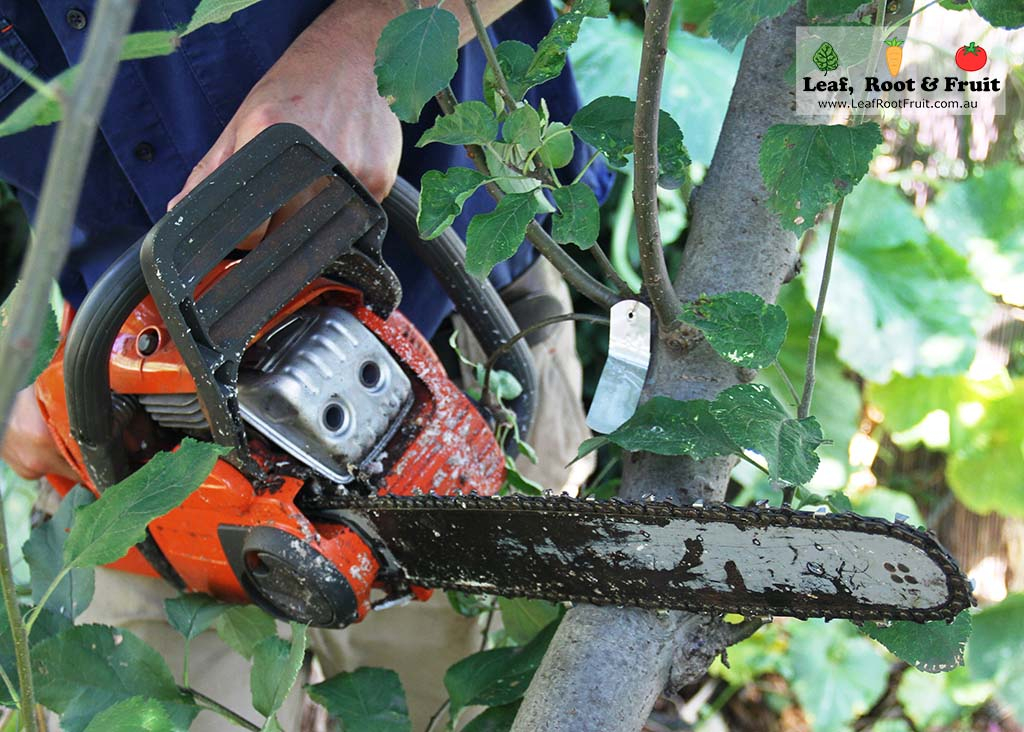
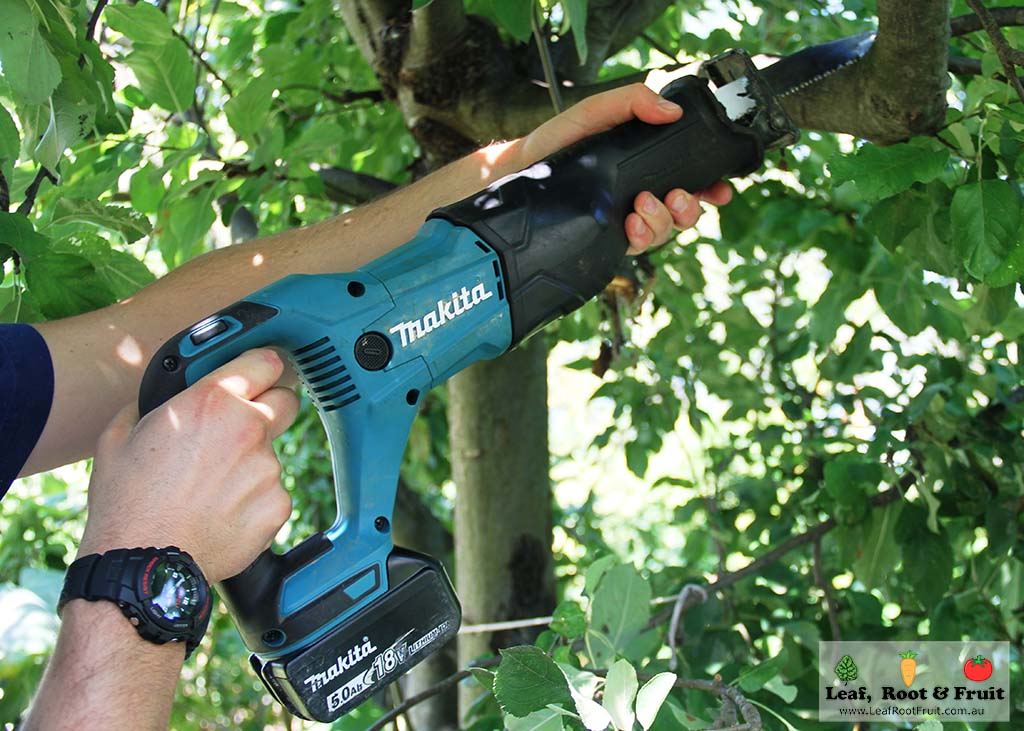
Spreader Bars

Spreader bars are a handy way to manoeuvre branches into a shape, more suited to fruit production. They can push branch angles out to a more productive angle. There are commercial options available or they are easy enough to make at home out of timber offcuts.
Alternatives to spreader bars are string and either weights or string and tent pegs.
Sterilising Spray Bottle
As part of good pruning hygiene it’s important to have something to sterilise your tools. I’ve transitioned away from jars that you dip your tool in, to spray bottles. This helps to reduce cross contamination, prevents spillages and broken glass jars and is a lot more convenient for staff to use.
My sterilising spray is made up of 70% water and 30% methylated spirits. Make sure you label the bottle appropriately to avoid mix ups or incidents.

Sharpener

It’s important to have sharp cutting tools. This ensures that your pruning cuts are cleaner, and require less effort than a dull blade. There are many sharpening options available. I don’t have a preference, as long as it is small enough to get into the jaws of your secateurs.
Please note: I do not receive any payment, free products or other incentives for mentioning any of the products featured in this blog.
Where to Cut?
As branches increase in size, they begin to develop a collar where they join the parent branch. When performing a thinning cut. Try to cut as close to collar of the branch as possible (without damaging the collar itself). Doing so enables the tree to heal the wound faster.
When performing a header cut, look for a dormant bud in the direction that you want the branch to grow (often this is an outward facing bud). Cut just above this dormant bud. Leaving a stub beyond the dormant bud will lead to die back of the stub and create a potential disease entry point.
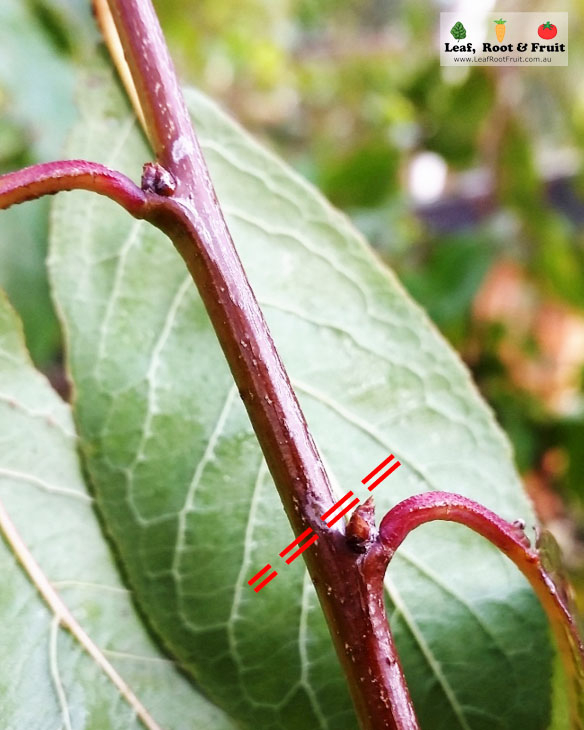
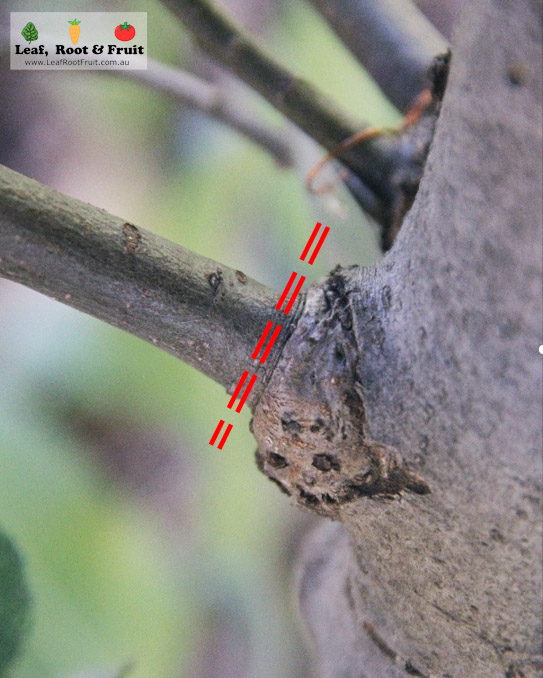
Removing Larger Limbs
Larger limbs are best removed in stages. Trying to remove a large limb with one cut, is likely to result in damage to the tree or tearing of the bark. This will reduce the tree’s ability to heal the wound and protect itself from disease.
Remove larger limbs at least 30 to 40 cm above where you want the final cut made. This will take the weight off the limb and make managing the cut easier. Take extra care when making the final cut. Support the weight of the final piece to be removed (a second person may be required to hold it, while you cut the piece free)
When making large cuts with e.g. a saw, or chainsaw, it’s a good idea to partially cut through the underside of the limb first. This will prevent the bark from tearing as the limb drops.
Winter vs Summer Pruning
It’s important to note that a fruit tree can be pruned at most times of the year (try to avoid autumn) and can even be pruned several times per year. I recommend summer pruning is done soon after the fruit has been picked from the tree.
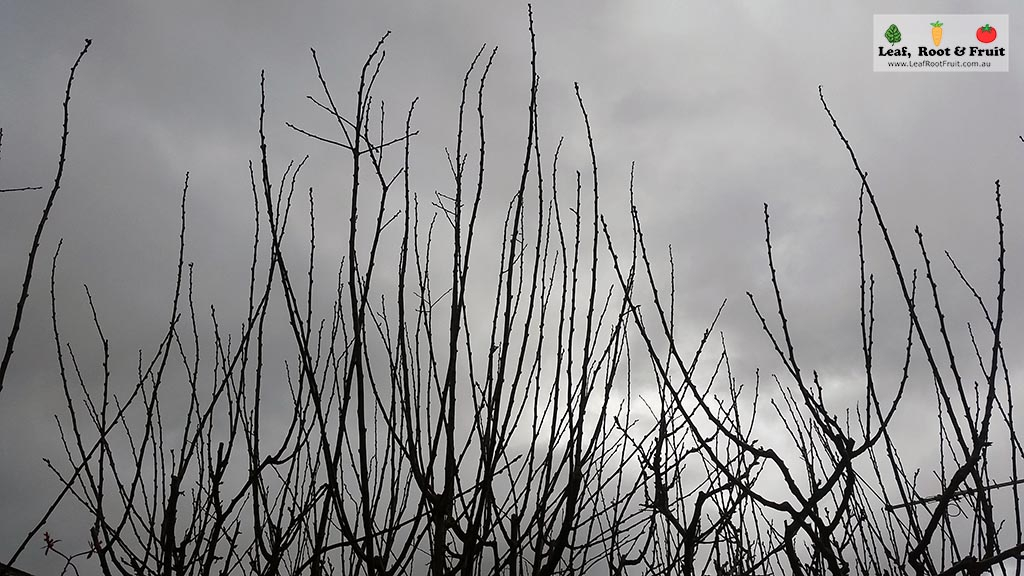
Pruning a tree during its dormancy in winter results in prolific growth at the top of the tree, often in the form of watershoots. All this vegetative growth is at the expense of fruit. When you prune a tree in winter, rather than promoting the growth of fruit, you’re just promoting the growth of more leaves to be pruned next winter. What a waste of time and effort!
Winter pruning is only recommended for newly planted trees until the tree has achieved the desired height and shape. Ideally, established fruit trees are pruned in late summer.
See my separate blog post for when to prune various fruit trees. While you are at it, have a read of this post about how to keep large fruit trees small.
Different Fruit Trees and Different Types of Fruiting Wood
A lot of confusion around fruit trees comes from the fact that different trees produce fruit on different parts of the plant. There are three main types of fruiting trees.
Apricots, Peaches, Nectarines & Japanese Plums
These trees fruit entirely on fresh growth. That is, the tree flowers and grows fruit only on branches that have grown during the previous summer. These types of trees are the most commonly affected by incorrect pruning. Often gardeners, who are unsure of what to do, will simply remove all of the previous year’s growth and take the tree back to the shape and timber that it was 12 months ago. In doing so, they remove all of the fruiting wood and get no fruit the following year.

Spur Bearers
The trees at the other end of the spectrum to peaches and nectarines, are spur bearing. Apples and pears are classic examples of spur bearers.
Fruiting spurs appear as slow growing, old and gnarled looking wood. In apples, each spur will produce about five flowers per spur and will fruit for up to 10 years (that’s 50 apples per spur over the life of the tree!). Spur formation is something we definitely want to encourage. We also want to avoid pruning or damaging them.
Spurs tend to form on slower growing timber and not on vigourous watershoots (another reason to avoid winter pruning!).

Unlike peaches and nectarines, you can usually safely remove all of the current years’ growth without affecting yields too much. Spur bearing trees are very forgiving when being pruned. Although, keep in mind that a few varieties of apples are in fact tip bearers (or a combination of both) and need to be managed differently.
Tip Bearers
Tip bearing fruit produce flower buds on the tips of growing shoots. Examples include citrus, persimmon, feijoa, a couple of apple varieties, fig, olives, pomegranate, loquat and quince.
Pruning tip bearing fruit trees is easy. Tip pruning (at the right time of the year) encourages multi-branching. More branches = more tips = more flowers = more fruit!
Hedge trimmers are a great way to prune tip-bearing fruit trees. Such trees produce the bulk of their fruit on the outer part of the canopy, with very little fruit produced inside the canopy. Therefore, once a tree gets beyond 2 to 3 metres in size, anything larger doesn’t lead to a substantial increase in fruit yields. That’s because the inside of the canopy can become a waste of space. This is especially the case for citrus trees.

A good shape for citrus trees to be pruned to, is a pear shape as per the image above. See this post for more information about pruning citrus trees.
Cherry Trees - The Spanish Bush Method
One of the traditional ways to keep these trees small is using a method called Spanish bush pruning. This strategy maintains your cherry tree as a small and dense bush.
How to Plan and Implement Your Pruning Strategy
It’s a good idea to stand back from the tree and envisage what you want your tree to look like once it has its established framework. Some of the tree shapes listed below may give you some inspiration. This gives you an overall strategy for pruning during the coming years. It’s a good idea that the same person carries out this strategy year after year. Older, established trees may already have the desired framework and all you need to do it maintain it.
Start by pruning the “Three Ds”: Dead, Diseased and Damaged branches. Then step back and see what’s left of the tree. Re-assess if and how the tree needs to be pruned to develop the tree structure you are after.
Start pruning other branches and limbs to align with your pruning strategy. Step back after each major cut and review what you are doing
Avoid the temptation to get carried away – stick to the original plan! Where possible, aim to prune less than 30% from an established tree in any pruning session. Doing more than this may result in excessive growth of foliage (and watershoots) in the coming months.
You can watch this timelapse video of me conducting a summer prune on a wind-damaged dwarf apricot. It should give you an idea of how to implement a pruning strategy.
Keeping Large Fruit Trees Small
You may have a monster in your garden, a fruit tree on a vigorous rootstock that’s taken off. You’d need a ladder to pick the fruit, if you could beat the birds, that is. But the tree has become too big to net, so the birds get the lot.
Each year you probably take to it with the secateurs in an attempt to restrain it, and each year it responds with even more vigour, reaching for the sky and taking over the entire garden.
If only there was a magic wand that you could wave to keep the tree small and productive.
Such a magic wand doesn’t exist. But I have put together a post listing a few different strategies that you might try to tame your fruit tree monster.
Fruit Tree Shapes
There are many different shapes that you can prune your trees into. You may come across variations such as ‘central leader’, ‘open vase’ and many different types of espalier. I don’t have a specific preference for one or the other. They all have pros and cons and the best choice needs to be determined by the person growing the tree. In many instances the choice mainly comes down to aesthetics. However, one shape I like to prune my trees to is a ‘closed canopy’
Closed Canopy Fruit Tree Shape
We have sunlight that is a lot more harsh in Melbourne, than say the Mediterranean region. As such, exposed fruit can often be sunburnt during our harsh summers. Having even access of sunlight (in e.g. an open vase shape) also means that all the fruit ripens at once. This is great for commercial orchards where a fruit picker can be asked to pick every fruit off the tree, knowing that it is ripe. However, in a backyard orchard we want extend our harvest by having some fruit on the tree ripen early and some that may be more shaded, ripen later.
Therefore, a closed canopy tree may be more appropriate for backyard orchards. To create this shape, I generally start by pruning to an open vase shape. Then when the tree approaches the desired height, we allow some of the branches to direct back inwards and created a closed canopy.
Once the fruit on the outer of the canopy has ripened, summer pruning can commence to allow light in to the shaded fruit to ripen.
Fruit Tree Espaliers

“Espalier” refers to special practices for training fruiting trees onto trellises. Espaliers save space and are beautiful works of art. There are many styles and designs of espalier that can be grown against a wall, a building or on an existing fence or wires. Espalier can also be used as a screen in the garden, to create rooms or to hide unsightly areas. Espaliers can use space along the drive that would be too small for a full tree. They provide interest in all seasons: stunning form in winter, flowers in spring, fruit in summer and autumn’s foliage.
See my separate guide for more information on how to set up and maintain fruit tree espaliers.
Want to Know More?
There’s a common joke in our industry:
“You can have five people standing around a fruit tree and eight different opinions on how to prune them!“
Nothing beats having someone stand in front of a tree and explain fruiting buds, tree shapes and the role of apical meristems to gain confidence in the art of fruit tree pruning. Rather than the “what” or the “how”, we focus on the “why” when supporting people to prune fruit trees.
If you are keen to join one of our fruit tree pruning classes, I normally host two workshops each year at our Demonstration Orchard in Kyneton:
- A fruit tree pruning masterclass focussing on Summer pruning held each February (when I believe we should be conducting much of our pruning activities)
- My Plant Physiology: Pruning and Plant Manipulation workshop held each June as part of the Science of Edible Gardening Workshop Series
See my events page for more details or sign up to my newsletter to be kept informed of upcoming classes.
Alternatively you can book in for a Fruit Tree Pruning Masterclass in your own garden


Craig Castree recommends pruning apple trees differently. Instead of cutting just past a leaf node he suggests cutting just before it. The resultant die back encourages spurs to form lower down the branch. I tried it on a tree that hardly ever produced fruit and now it’s loaded.
Hi Eileen,
Thanks for sharing this with us. I haven’t come across this before and will give it a go on a few trees to see what impact it has.
Good Luck & Happy Gardening!
Duncan
Hi Duncan, I can recommend Craig’s approach. Cut just under the 3rd or 4th bud to interrupt the flow – this encourages fruit spurs on pomme trees.
Cheers Tony
Thanks for the tip. Happy gardening.
Hi Duncan, we have inherited two established pear trees from the previous owners, and the trees have been heavily top pruned (about 2m high) in a vase shape. Wondering if you have any thoughts on how effective top pruning is? We are finding a lot of the new growth is for whippy water shoots from where the branches have been topped – I’m not sure if we should try to maintain the topping or whether to let some of the water shoots form into new branches. Thank you
Hi Katie,
Thanks for the question. It’s a very difficult one for me to answer, especially in a simple comment format. Last Friday I ran a fruit tree pruning workshop and spent about three hours explaining what is essentially an answer to this very question. Even if we were standing in front of your pear tree together, I’d still be giving you several different options for how to prune it.
There are infinite ways to prune a fruit tree. All have different consequences, but all are valid. So firstly it depends on what your aims and limitations are, and they can vary a lot. The more you prune, the more and bigger the tree will grow. This may be a good or a bad thing depending on your aims. But pruning must be approached more holistically than that. Pruning is just one aspect of plant manipulation. You also need to consider fertilising, watering, seasonal variation, previous fruit yields, biennial cropping patterns, future fruit yields, pest attack (previous and future), the list goes on and on. It’s complex to explain in person with a tree in front of us, but even more difficult to explain in a blog post (which is why I haven’t done so thus far).
This post will help explain some of it, but won’t answer your question specifically.
Thanks for your understanding, but it is very much a “how long is a piece of string?” kinda question.
Happy gardening
Duncan
I also have a Beurre Bosc pear tree. It’s ten years old and has never flowered, let alone fruited. I bought it to help the Williams pear next to it. Leki you, I’ve rarely watered it. It has been kept under about 2 1/2 metres high, but has only needed pruning the last year or so. What might I be doing wrong.
Hi Eileen,
I’d expect that even if it were on a very slow rootstock that it would be flowering by now. Is it it full sun? Maybe possums are eating all the flower buds? Perhaps it needs a little bit more water in spring to help get it into the habit of blossoming? Is it growing in a pot or the ground? It’s difficult for me to diagnose further without seeing the tree and knowing a lot more.
I don’t usually worry about cross pollination of fruit trees growing in suburbia. There’s usually another compatible tree growing nearby that the bees can visit and provide their pollination services. Is the Williams pear producing?
Sorry I can’t be more specific with advice on this one.
Duncan
This information is gold! Thankyou for sharing
Thanks Tony, I’m glad that you found it useful.
Happy gardening
Duncan